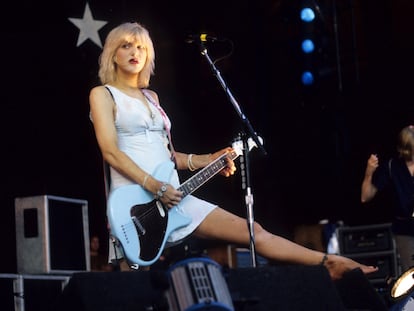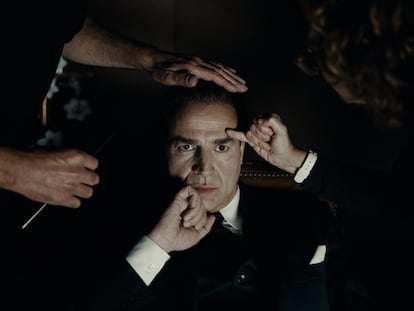Thom Browne: Fifty shades of gray
A lover of uniforms and of garments that tell stories, the designer has been building a unique, inimitable discourse for two decades
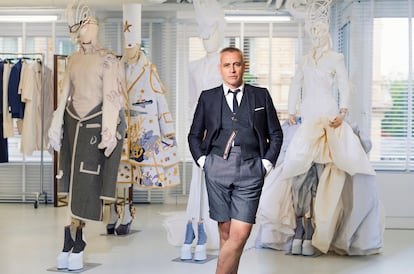
Avenue Montaigne, in Paris, is one of the most famous luxury shopping streets in the world. Among the magnificent historic haute couture houses and the huge exclusive boutiques with dozens of tourists standing in line at the door, there is a gray cement office building; bland, if not for the fact that it is a discordant element in the area’s architecture. On the second floor one can find Thom Browne’s atelier, an open space, more similar to an office than a designer’s studio, which also functions as a by-appointment shop. Of course, neither the space nor the decoration are fortuitous.
These are the days after Browne’s first show at the very exclusive Paris Haute Couture Week (he is the first American designer to present his collection at this elitist event in the last 50 years) and several people on his team are putting the finishing touches on the different pieces for appointments with buyers. They are all young and they all wear what Browne calls the “uniform”: gray suits with shorts, pleated skirts or cropped pants over tight white shirts. “You always have to be consistent with what you create, be faithful to a vision. I think that is the key to success,” says the designer. That coherence, in Browne’s curious imagination, is taken to the extreme.
He created his brand 20 years ago, and neither he nor those around him have ever been seen without the uniform. Thanks to this, he is one of the few contemporary creators whose work is instantly recognizable; it does not matter if they are worn by men or women, if they are complicated dresses or simple suits. Everyone knows that those clothes bear his signature.
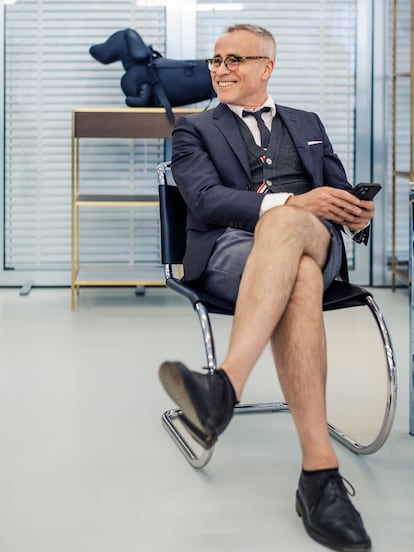
Things were not so easy at first. Two decades ago, men’s fashion was beginning to awaken, flirting with luxury sportswear. Hedi Slimane triumphed at Dior Men with tight-fitting suits that evoked the rock stars of the 1970s, and Browne, oblivious to the trend of the moment, began to design gray suits, apparently bland, aside from the fact that they seemed to be shrunken. That uniform, which conveyed — and continues to convey — a curious mix of discipline and irony, was the visual result of his strict education at a Catholic school in Pennsylvania, his years as a high-level swimmer (the three stripes of his logo are inspired on the medal ribbons) and his time in the creative team of Club Monaco, a historic, Ivy League-style brand that once belonged to Ralph Lauren. It was he who trusted Browne, who had no academic training in fashion, and gave him a position on the design team after having worked in his stores.
Many people did not understand what he was doing, he recalls. They thought it looked bad. Still, the designer was convinced that one has to be faithful to the story one wants to tell. Then some people started to get it; people like David Bowie, who trusted him to design his suits back when the designer, before starting to present his collections in 2006, only owned a small custom clothing workshop in the West Village (in the last public image of the artist before his death, he is wearing a tight-fitting Browne uniform). Or people like Claudio Del Vecchio, at the time the owner of the historic American tailoring firm Brooks Brothers, who hired him from 2007 to 2012 to create the conceptual tailoring line Black Fleece.
That, along with his subsequent collections for Moncler, helped him expand his vision beyond the confines of New York. Suddenly, Browne’s suits were the uniform of the moment, and he and his partner, Andrew Bolton, curator of the Metropolitan Museum of Art’s Costume Institute, became two of the most influential people in the industry. “I guess what happened is that a connection was created with a certain type of audience. A uniform seems boring, but it can be liberating and tell the story of the person who wears it. I may have more clients now, but the profile has not changed. They are people who want to express something through their style, regardless of the trends of the moment,” he says.
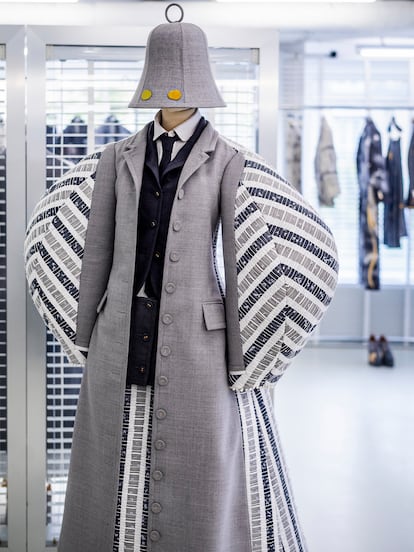
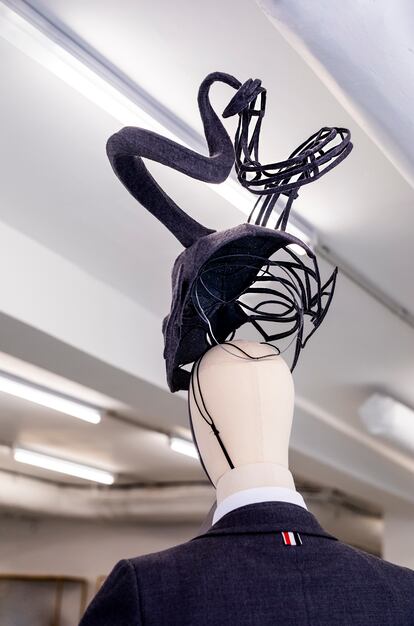
History is everything to Browne, since long before he created the brand, back when he used to rummage through vintage stores in order to dress (always in uniform, of course) in a different style from the rest. It has been for all these years, with shows held at swimming pools, train stations and, of course, offices. Also, when he launched his women’s line, in 2013, equally recognizable but infinitely more theatrical than the men’s line. “And it will continue to be that way. Not only because it is what the public expects of me, but also because I don’t know how to do things any other way. I can only devise collections if I imagine stories,” he admits. A good example is his latest show, the first in the sphere of haute couture. At the Paris Opera, and before the “watchful gaze” of 1,000 cardboard mannequins dressed in gray and placed among the audience, supermodel Alek Wek starred in a sort of performance in which she saw her own life go by, apparently anodyne until one realized that there was a certain courage within that monochromatic biography. Of course, Fade to Grey was played, as well as Station to Station as a tribute to Bowie, his main supporter. “Everything had to be gray, because it’s my story,” he says, “but I also wanted it to be a demonstration of what can be achieved using the suit as a creative base,” he says about these dramatic handcrafted designs.
Ultimately, Browne’s foray into the closed world of haute couture was a kind of self-tribute to his 20 years of creative audacity, an anniversary that was topped off with a book that goes over his entire career, written by his partner and published by Rizzoli. “But I also wanted it to be a sample of what can be achieved within American fashion,” he states. “We have a deep-rooted tradition linked to the suit, in its most creative sense.” Last year, Browne replaced Tom Ford as Chairman of the Council of Fashion Designers of America. His mission is to support the new generation of creators so that they can develop their own story, inside and outside the U.S. — a story that “must entertain and provoke.” That is, it must find a similar path to the one he undertook 20 years ago. Other than that, when asked about the future, his response is succinct: “I want to remain true to my story.”
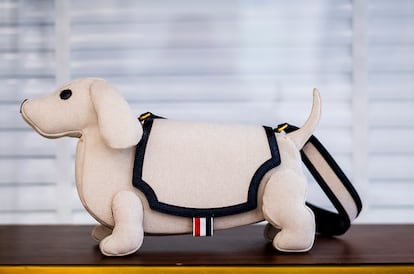
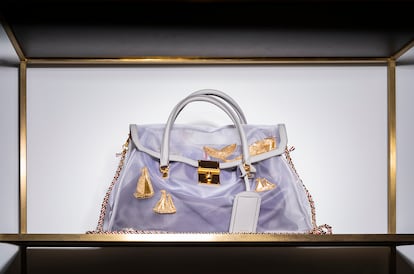
Sign up for our weekly newsletter to get more English-language news coverage from EL PAÍS USA Edition
Tu suscripción se está usando en otro dispositivo
¿Quieres añadir otro usuario a tu suscripción?
Si continúas leyendo en este dispositivo, no se podrá leer en el otro.
FlechaTu suscripción se está usando en otro dispositivo y solo puedes acceder a EL PAÍS desde un dispositivo a la vez.
Si quieres compartir tu cuenta, cambia tu suscripción a la modalidad Premium, así podrás añadir otro usuario. Cada uno accederá con su propia cuenta de email, lo que os permitirá personalizar vuestra experiencia en EL PAÍS.
¿Tienes una suscripción de empresa? Accede aquí para contratar más cuentas.
En el caso de no saber quién está usando tu cuenta, te recomendamos cambiar tu contraseña aquí.
Si decides continuar compartiendo tu cuenta, este mensaje se mostrará en tu dispositivo y en el de la otra persona que está usando tu cuenta de forma indefinida, afectando a tu experiencia de lectura. Puedes consultar aquí los términos y condiciones de la suscripción digital.
More information
Archived In
Últimas noticias
There is as much life left to discover on planet Earth as that which is already known
Dozens presumed dead, around 100 injured in fire at Swiss Alps bar during New Year’s celebration
Is porn for women different from conventional porn? We spoke to those who make it
Cartagena de Indias is sinking: What can the city do to mitigate it?
Most viewed
- Reinhard Genzel, Nobel laureate in physics: ‘One-minute videos will never give you the truth’
- David King, chemist: ‘There are scientists studying how to cool the planet; nobody should stop these experiments from happening’
- Oona Chaplin: ‘I told James Cameron that I was living in a treehouse and starting a permaculture project with a friend’
- Sinaloa Cartel war is taking its toll on Los Chapitos
- The Interoceanic Train, the Mexican alternative to the Panama Canal

